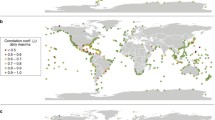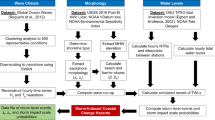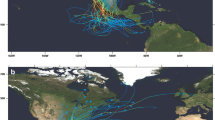Abstract
The occurrence of extreme water levels along low-lying, highly populated and/or developed coastlines can lead to considerable loss of life and billions of dollars of damage to coastal infrastructure. Therefore it is vitally important that the exceedance probabilities of extreme water levels are accurately evaluated to inform risk-based flood management, engineering and future land-use planning. This ensures the risk of catastrophic structural failures due to under-design or expensive wastes due to over-design are minimised. This paper estimates for the first time present day extreme water level exceedence probabilities around the whole coastline of Australia. A high-resolution depth averaged hydrodynamic model has been configured for the Australian continental shelf region and has been forced with tidal levels from a global tidal model and meteorological fields from a global reanalysis to generate a 61-year hindcast of water levels. Output from this model has been successfully validated against measurements from 30 tide gauge sites. At each numeric coastal grid point, extreme value distributions have been fitted to the derived time series of annual maxima and the several largest water levels each year to estimate exceedence probabilities. This provides a reliable estimate of water level probabilities around southern Australia; a region mainly impacted by extra-tropical cyclones. However, as the meteorological forcing used only weakly includes the effects of tropical cyclones, extreme water level probabilities are underestimated around the western, northern and north-eastern Australian coastline. In a companion paper we build on the work presented here and more accurately include tropical cyclone-induced surges in the estimation of extreme water level. The multi-decadal hindcast generated here has been used primarily to estimate extreme water level exceedance probabilities but could be used more widely in the future for a variety of other research and practical applications.










Similar content being viewed by others
References
Bernier NB, Thompson KR (2006) Predicting the frequency of storm surges and extreme water levels in the northwest Atlantic. J Geophys Res Oceans 111:C10009
Bindoff NL, Willebrand J, Artale V, Cazenave A, Gregory J, Gulev S, Hanawa K, Le Quéré C, Levitus S, Nojiri Y, Shum CK, Talley LD, Unnikrishnan A (2007) Observations: oceanic climate change and sea level. In: Solomon S, Qin D, Manning M, Chen Z, Marquis M, Averyt KB, Tignor M, Miller HL (eds) Climate change 2007: the physical science basis. Contribution of working group I to the fourth assessment report of the intergovernmental panel on climate change. Cambridge University Press, Cambridge, pp 385–432
Butler A, Heffernan JE, Tawn JA, Flather RA, Horsburgh KJ (2007) Extreme value analysis of long-term variations in storm surges. J Mar Syst 67:189–200
Colberg F, McInnes KL (2012) The impact of storminess changes on extreme sea levels over southern Australia. GR-Oceans (in press). doi:10.1029/2012JC007919
Coles S (2001) An introduction to statistical modelling of extreme values. Springer, Berlin
Danish Hydraulic Institute (2010) Mike 21 & Mike 3 flow model FM, Hydrodynamic and transport module scientific documentation
Debernard J, Saetra O, Roed LP (2002) Future wind, wave and storm surge climate in the northern North Atlantic. Clim Res 23(1):39–49
Department of Climate Change (2009) Climate change risks to Australia’s coast: a first pass national assessment, p 168. Accessed 07/06/2012. http://www.climatechange.gov.au/~/media/publications/coastline/cc-risks-full-report.pdf
Dixon MJ, Tawn JA (1999) The effect of non-stationary on extreme sea-level estimation. Appl Stat 48(2):135–151
Egbert GD, Erofeeva S (2002) Efficient inverse modeling of barotropic ocean tides. J Atmos Oceanic Technol 19(2):183–204
Egbert GD, Bennett AF, Foreman MGG (1994) TOPEX/POSEIDON tides estimated using a global inverse model. J Geophys Res 99(C12):24821–24852
Eliot M (2012) Sea level variability influencing coastal flooding in the Swan River region, Western Australia. Cont Shelf Res 33:14–28
Fandry CB, Hubbert GD, McIntosh PC (1985) Comparison of predictions of a numerical model and observations of tides in Bass Strait. Aust J Mar Freshw Res 36(6):737–752
Flather RA (1987) Estimates of extreme conditions of tide and surges using a numerical model of the North-west European Continental Shelf. Estuar Coast Shelf Sci 24:69–93
Flather RA (2000) Existing operational oceanography. Coastal Eng 41:13–40
Flather RA, Smith JA (1998) First estimates of changes in extreme storm surge elevations due to the doubling of CO2. Glob Atmos Ocean Syst 6(2):193–208
Flather RA, Smith JA, Richards JD, Bell C, Blackman DL (1998) Direct estimates of extreme storm surge elevations from a 40-year numerical model simulation and from observations. Glob Atmos Ocean Syst 6:165–176
Haigh ID, MacPherson LR, Mason MS, Wijeratne EMS, Pattiaratchi CB, Crompton RP, George S (2013) Estimating present day extreme total water level exceedance probabilities around the coastline of Australia: tropical cyclone-induced storm surges. Clim Dyn. doi:10.1007/s382-012-1653-0
Haigh ID, Nicholls RJ, Wells NC (2010) A comparison of the main methods for estimating probabilities of extreme still water levels. Coast Eng 57(9):838–849
Haigh ID, Nicholls RJ, Wells NC (2011a) Rising sea levels in the English Channel 1900 to 2100. Proc ICE Marit Eng 164(2):81–92
Haigh ID, Eliot M, Pattiaratchi C (2011b) Global influences of the 18.61 year nodal cycle and 8.85 year cycle of lunar perigee on high tidal levels. J Geophys Res 116:C06025. doi:10.1029/2010JC006645
Haigh ID, Eliot M, Pattiaratchi C (2011c) Regional changes in mean sea level around Western Australia between 1897 and 2008. Coasts and Ports Conference, Perth, Australia
Harper BA (ed) (2001) Queensland climate change and community vulnerability to tropical cyclones—ocean hazards assessment stage 1—review of technical requirements. Report prepared by Systems Engineering Australia Pty Ltd in association with James Cook University Marine Modelling Unit, Queensland Government, 375 pp, March 2001
Horsburgh KL, Wilson C (2007) Tide-surge interaction and its role in the distribution of surge residuals in the North Sea. J Geophys Res 112:CO8003
Kalnay E, Kanamitsu M, Kistler R, Collins W, Deaven D, Gandin L, Iredell M, Saha S, White G, Woollen J, Zhu Y, Leetmaa A, Reynolds R, Chelliah M, Ebisuzaki W, Higgins W, Janowiak J, Mo KC, Ropelewski C, Wang J, Jenne R, Joseph D (1996) The NCEP/NCAR 40-year reanalysis project Bull. Am Meteorol Soc 77:437–470
Kistler R, Kalnay E, Collins W, Saha S, White G, Woollen J, Chelliah M, Ebisuzaki W, Kanamitsu M, Kousky V, Dool H, Jenne R, Fiorino M (2001) The NCEP-NCAR 50-year reanalysis: monthly means CD ROM and documentation. Bull Am Meteorol Soc 82(2):247–267
Langenberg H, Pfizenmayer A, von Storch H, Sündermann J (1999) Storm-related sea level variations along the North Sea coast: natural variability and anthropogenic change. Cont Shelf Res 19(6):821–842
Lowe JA, Gregory JM (2005) The effects of climate change on storm surges around the United Kingdom. Philos Trans R Soc Lond A363(1831):1313–1328
Lowe JA, Gregory JM, Flather RA (2001) Changes in the occurrence of storm surges around the United Kingdom under a future climate scenario using a dynamic storm surge model driven by the Hadley Centre climate models. Clim Dyn 18(3/4):179–188
Lowe JA, Woodworth PL, Knutson T, McDonald RE, McInnes K, Woth K, Von Storch H, Wolf J, Swail V, Bernier N, Gulev S, Horsburgh K, Unnikrishnan AS, Hunter J, Weisse R (2010) Past and future changes in extreme water levels and waves. In: Church JA, Woodworth PL, Aarup T, Wilson S (eds) Understanding sea-level rise and variability. Wiley-Blackwell, Hoboken
McInnes KL, Hubbert GD (2003) A numerical modelling study of storm surges in Bass Strait. Aust Meteorol Mag 52(3):143–156
McInnes KL, Macadam I, Hubbert GD, O’Grady JD (2009) A modelling approach for estimating the frequency of sea level extremes and the impact of climate change in southeast Australia. Nat Hazards 51:115–137
McInnes KL, Macadam I, Hubbert GD, O’Grady JG (2011a) An assessment of current and future vulnerability to coastal inundation due to sea level extremes in Victoria, southeast Australia. Int J Clim. doi:10.1002/joc.3405
McInnes KL, O’Grady JG, Hemer M, Macadam I, Abbs DJ, White CJ, Bennett JC, Corney SP, Holz GK, Grose MR, Gaynor SM, Bindoff NL (2011b) Climate future for Tasmania: Extreme tide and sea-level events. Technical report, Antarctic Climate and Ecosystems Corporate Research Centre
McIntosh PC, Bennett AF (1984) Open ocean modeling as an inverse problem: M2 tides in Bass Strait. J Phys Oceanogr 14(3):601–614
McMillan A, Batstone C, Worth D, Tawn J, Horsburgh K, Lawless M (2011) Coastal flood boundary conditions for UK mainland and islands. Technical report, Project: SC060064/TR2. Accessed 30/08/2011. http://publications.environment-agency.gov.uk/PDF/SCHO0111BTKI-E-E.pdf
Meehl GA, Stocker TF, Collins WD, Friedlingstein P, Gaye AT, Gregory JM, Kitoh A, Knutti R, Murphy JM, Noda A, Raper SCB, Watterson IG, Weaver AJ, Zhao ZC (2007) Global climate projections. In: Solomon S, Qin D, Manning M, Chen Z, Marquis M, Averyt KB, Tignor M, Miller HL (eds) Climate change 2007: the physical science basis. Contribution of working group I to the fourth assessment report of the intergovernmental panel on climate change. Cambridge University Press, Cambridge, pp 747–845
Nicholls RJ, Wong PP, Burkett VR, Codignotto JO, Hay JE, McLean RF, Ragoonaden S, Woodroffe CD (2007) Coastal systems and low-lying areas. In: Parry ML et al (eds) Climate change 2007: impacts, adaptation and vulnerability, contribution of working group II to the fourth assessment report of the intergovernmental panel on climate change. Cambridge University Press, Cambridge, pp 315–356
O’Grady JG, McInnes KL (2010) Extreme wind waves and their relationship to storm surges in northeastern Bass Strait. Aust Meteorol Oceanogr J 60:265–275
Pawlowicz R, Beardsley B, Lentz S (2002) Classical tidal harmonic analysis including error estimates in MATLAB using T_TIDE. Comput Geosci 28(8):929–937
Pugh DT (1987) Tides, surges and mean sea-level. A handbook for engineers and scientists. Wiley, Chichester
Pugh DT (2004) Changing sea levels: effects of tides, weather and climate. Cambridge University Press, Cambridge
Pugh DT, Vassie JM (1979) Extreme sea-levels from tide and surge probability. In: Proceedings of the 16th coastal engineering conference, Hamburg, German, 27 Aug–3 Sep 1978, vol 1. American Society of Civil Engineers, New York, pp 911–930
Pugh DT, Vassie JM (1980) Applications of the joint probability method for extreme sea- level computations. Proc Inst Civil Eng Part 2(69):959–975
Sebastiao P, Soares CG, Alvarez E (2008) 44 years hindcast of sea level in the Atlantic Coast of Europe. Coast Eng 55(11):843–848
Seneviratne SI, Nicholls N, Easterling D, Goodess CM, Kanae S, Kossin J, Luo Y, Marengo J, McInnes K, Rahimi M, Reichstein M, Sorteberg A, Vera C, Zhang X (2012) Changes in climate extremes and their impacts on the natural physical environment. In: Field CB, Barros V, Stocker TF, Qin D, Dokken DJ, Ebi KL, Mastrandrea MD, Mach KJ, Plattner GK, Allen SK, Tignor M, Midgley PM (eds) Managing the risks of extreme events and disasters to advance climate change adaptation. A special report of working groups I and II of the intergovernmental panel on climate change (IPCC). Cambridge University Press, Cambridge, pp 109–230
Sterl A (2004) On the (in)homogeneity of reanalysis products. J Clim 17(19):3866–3873
Tawn JA, Vassie JM (1989) Extreme sea-levels: the joint probabilities method revisited and revised. Proc Inst Civil Eng Part 2(87):249–442
Tsimplis MN, Woolf DK, Osborn T, Wakelin S, Woodworth P, Wolf J, Flather R, Blackman D, Shaw AGP, Pert F, Challenor P, Yan Z (2005) Towards a vulnerability assessment of the UK and northern European coasts: the role of regional climate variability. Philos Trans R Soc Lond A363(1831):1329–1358
Unnikrishnan AS, Rupa Kumar K, Fernandes SE, Michael GS, Patwardhan SK (2006) Sea level changes along the Indian coast: observations and projections. Curr Sci 90(3):362–368
Uppala SM, Kållberg PW, Simmons AJ, Andrae U, da Costa Bechtold V, Fiorino M, Gibson JK, Haseler J, Hernandez A, Kelly GA, Li X, Onogi K, Saarinen S, Sokka N, Allan RP, Andersson E, Arpe K, Balmaseda MA, Beljaars ACM, van de Berg L, Bidlot J, Bormann N, Caires S, Chevallier F, Dethof A, Dragosavac M, Fisher M, Fuentes M, Hagemann S, Hólm E, Hoskins BJ, Isaksen L, Janssen PAEM, Jenne R, McNally AP, Mahfouf J-F, Morcrette J–J, Rayner NA, Saunders RW, Simon P, Sterl A, Trenberth KE, Untch A, Vasiljevic D, Viterbo P, Woollen J (2005) The ERA-40 re-analysis. Q J R Meteorol Soc 131:2961–3012. doi:10.1256/qj.04.176
von Storch H, Woth K (2008) Storm surges: perspectives and options. Sustain Sci 3:33–43
Wakelin SL, Woodworth PL, Flather RA, Williams JA (2003) Sea-level dependence on the NAO over the NW European Continental Shelf. Geophys Res Lett 30(7):1403
Webster MA, Petkovic P (2005) Australian bathymetry and topography grid, June 2005. Record 2005/12
Weisse R, Plüβ A (2006) Storm-related sea level variations along the North Sea coast as simulated by a high-resolution model 1958–2002. Ocean Dyn 56:16–25
Wijeratne EMS, Pattiaratchi C, Haigh ID, Eliot M (in preparation) The seasonal cycle of sea level around Australia. J Geophys Res Oceans (plan to submit)
Wijeratne EMS, Pattiaratchi C, Eliot M, Haigh ID (2012) Tidal characteristics in Bass Strait, southeast Australia. Estuar Coast Shelf Res 114:156–165
Woodworth PL, Flather RA, Williams JA, Wakelin SL, Jevrejeva S (2007) The dependence of UK extreme water levels and storm surges on the North Atlantic Oscillation. Cont Shelf Res 27:935–946
Woodworth PL, Teferle RM, Bingley RM, Shennan I, Williams SDP (2009) Trends in UK mean sea level revisited. Geophys J Int 176(1):19–30
Woth K (2005) North Sea storm surge statistics based on projections in a warmer climate: how important are the driving GCM and the chosen emission scenario? Geophys Res Lett 32:L22708
Woth K, Weisse R, von Storch H (2006) Climate change and North Sea storm surge extremes: an ensemble study of storm surge extremes expected in a changed climate projected by four different regional climate models. Ocean Dyn 56:3–15
Zhang K, Douglas BC, Leatherman SP (1997) East coast storm surges provide unique climate record. EOS Trans Am Geophys Union 78(37):389–397
Zhang K, Douglas BC, Leatherman SP (2000) Twentieth-century storm activity along the US east coast. J Clim 13:1748–1761
Acknowledgments
We would like to thank the Australian National Tidal Centre, Western Australian Department of Transport, Sydney Ports Corporation and Fremantle Ports for supplying the tide-gauge datasets, Tessa Jakszewicz for managing the project, and Matthew Eliot for useful discussions regarding the study. We would also like to acknowledge Kathleen McInnes, Robert Nicholls, Thomas Wahl and an anonymous reviewer whose helpful comments and suggestions greatly improved the final paper. This study was funded by the Australian Department of Climate Change and Energy Efficiency and the Western Australian Department of Transport, and builds on an earlier study funded by the Western Australian Marine Science Institution.
Author information
Authors and Affiliations
Corresponding author
Rights and permissions
About this article
Cite this article
Haigh, I.D., Wijeratne, E.M.S., MacPherson, L.R. et al. Estimating present day extreme water level exceedance probabilities around the coastline of Australia: tides, extra-tropical storm surges and mean sea level. Clim Dyn 42, 121–138 (2014). https://doi.org/10.1007/s00382-012-1652-1
Received:
Accepted:
Published:
Issue Date:
DOI: https://doi.org/10.1007/s00382-012-1652-1




